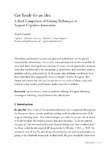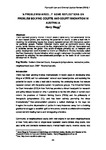Engineering Innovation (TRIZ based Computer Aided Innovation)
| dc.contributor.supervisor | Filmore, Dr Paul | |
| dc.contributor.author | Shahdad, Mir Abubakr | |
| dc.contributor.other | School of Engineering, Computing and Mathematics | en_US |
| dc.date.accessioned | 2015-04-21T14:37:07Z | |
| dc.date.available | 2015-04-21T14:37:07Z | |
| dc.date.issued | 2015 | |
| dc.date.issued | 2015 | |
| dc.identifier | 10208564 | en_US |
| dc.identifier.uri | http://hdl.handle.net/10026.1/3317 | |
| dc.description.abstract |
This thesis describes the approach and results of the research to create a TRIZ based computer aided innovation tools (AEGIS and Design for Wow). This research has mainly been based around two tools created under this research: called AEGIS (Accelerated Evolutionary Graphics Interface System), and Design for Wow. Both of these tools are discussed in this thesis in detail, along with the test data, design methodology, test cases, and research. Design for Wow (http://www.designforwow.com) is an attempt to summarize the successful inventions/ designs from all over the world on a web portal which has multiple capabilities. These designs/innovations are then linked to the TRIZ Principles in order to determine whether innovative aspects of these successful innovations are fully covered by the forty TRIZ principles. In Design for Wow, a framework is created which is implemented through a review tool. The Design for Wow website includes this tool which has been used by researcher and the users of the site and reviewers to analyse the uploaded data in terms of strength of TRIZ Principles linked to them. AEGIS (Accelerated Evolutionary Graphics Interface System) is a software tool developed under this research aimed to help the graphic designers to make innovative graphic designs. Again it uses the forty TRIZ Principles as a set of guiding rules in the software. AEGIS creates graphic design prototypes according to the user input and uses TRIZ Principles framework as a guide to generate innovative graphic design samples. The AEGIS tool created is based on TRIZ Principles discussed in Chapter 3 (a subset of them). In AEGIS, the TRIZ Principles are used to create innovative graphic design effects. The literature review on innovative graphic design (in chapter 3) has been analysed for links with TRIZ Principles and then the DNA of AEGIS has been built on the basis of this study. Results from various surveys/ questionnaires indicated were used to collect the innovative graphic design samples and then TRIZ was mapped to it (see section 3.2). The TRIZ effects were mapped to the basic graphic design elements and the anatomy of the graphic design letters was studied to analyse the TRIZ effects in the collected samples. This study was used to build the TRIZ based AEGIS tool. Hence, AEGIS tool applies the innovative effects using TRIZ to basic graphic design elements (as described in section 3.3). the working of AEGIS is designed based on Genetic Algorithms coded specifically to implement TRIZ Principles specialized for Graphic Design, chapter 4 discusses the process followed to apply TRIZ Principles to graphic design and coding them using Genetic Algorithms, hence resulting in AEGIS tool. Similarly, in Design for Wow, the content uploaded has been analysed for its link with TRIZ Principles (see section 3.1 for TRIZ Principles). The tool created in Design for Wow is based on the framework of analysing the TRIZ links in the uploaded content. The ‘Wow’ concept discussed in the section 5.1 and 5.2 is the basis of the concept of Design for Wow website, whereby the users upload the content they classify as ‘Wow’. This content then is further analysed for the ‘Wow factor’ and then mapped to TRIZ Principles as TRIZ tagging methodology is framed (section 5.5). From the results of the research, it appears that the TRIZ Principles are a comprehensive set of innovation basic building blocks. Some surveys suggest that amongst other tools, TRIZ Principles were the first choice and used most .They have thus the potential of being used in other innovation domains, to help in their analysis, understanding and potential development. | en_US |
| dc.description.sponsorship | Great Western Research and Systematic Innovation Ltd UK | en_US |
| dc.language.iso | en | en_US |
| dc.publisher | Plymouth University | en_US |
| dc.subject | TRIZ | en_US |
| dc.subject | Machine Learning | en_US |
| dc.subject | Self Learning Adaptive Software | en_US |
| dc.subject | Computer Aided Innovation | en_US |
| dc.subject | Genetic Algorithm | en_US |
| dc.subject | TRIZ applied to Graphic Design | en_US |
| dc.subject | Graphic Design Systematic Innovation | en_US |
| dc.subject | DNA of innovation | en_US |
| dc.subject | innovation atoms and molecules | en_US |
| dc.title | Engineering Innovation (TRIZ based Computer Aided Innovation) | en_US |
| dc.type | Thesis | |
| plymouth.version | Edited version | en_US |
| dc.identifier.doi | http://dx.doi.org/10.24382/3546 |
Files in this item
This item appears in the following Collection(s)
-
01 Research Theses Main Collection
Research Theses Main





